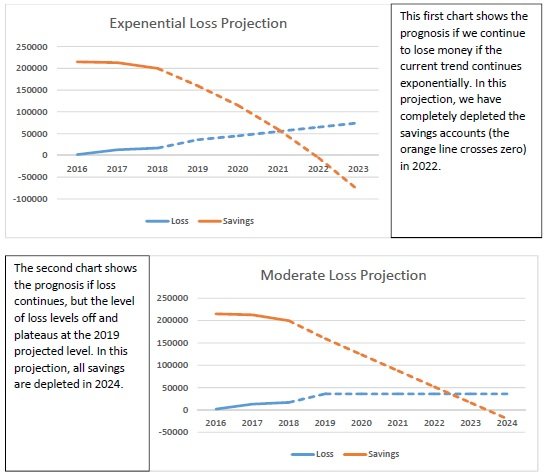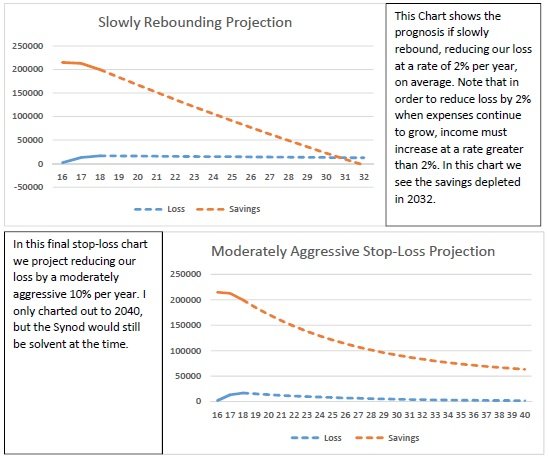First, an apology. Last year at Synod Assembly the assembly asked for a white-paper well in advance of the next Synod Assembly. Well in advance is a flexible phrase, but I don’t think I met it by anyone’s standards. Family and work emergencies that persisted for longer than two months kept it from being possible for me, and the result is a white-paper coming out at the same time any other report of the treasurer would come out. I am sorry.
For those who don’t know the background, the Synod is in a rough financial position, and, if current trends persist, it is not sustainable. In 2016 we lost a little over $2000. In 2017 we lost $13,199. In 2018 we lost $16,813. In 2018 we lost less than we projected to lose thanks to large non-regular gifts to the Synod totaling over $20,000. We had initially projected to lose about $23,000, but as the year went on, it became clear that we could have lost closer to $37,000 had it not been for those non-regular gifts. We projected ourselves to lose $36,000 in this fiscal year, but without any other surprise gifts, we will likely come in over that projection.
This position didn’t start in 2016, it goes back much further. At the time of the formation of the ELCA, the Commission for a New Lutheran Church (CNLC) identified 150-200 congregations as being the magic number for a sustainable Synod. With this number in mind they did their best to carve out synods considering a variety of factors as they saw fit. The WV-WMD Synod was a new synod, and it was one of the few synods with fewer than 100 congregations.
Just prior to the economic collapse of 2008; the Synod saw a reduction in mission support due to issues of conflict in three congregations. The economic recession of 2008 hurt our already economically distressed territory, and all of Appalachia, especially hard. Giving began to decrease. The recession ended, and for a short term, giving increased a little, but it began decreasing again.
Following controversial decisions made at the Churchwide Assembly in 2009, two congregations chose to leave the WV-WMD Synod and the ELCA altogether. One of these congregations accounted for about 4.5% of the support coming into the Synod. Other congregations saw a loss in giving members, which also affected overall support.
The Synod was not unresponsive when the writing on the wall started to come into focus. Mission support to the ELCA was cut from 51.5% all the way down to 33% where it is now. Entire line items in the budget were removed. The then-treasurer and Finance Committee went after some lines in the budget with a scalpel, and other lines with a chain saw. Our budget is now a skeleton of what it once was, but the work is not done.
I am including as an appendix a document that Bishop Riegel prepared for our November Mission Support Consultation. Find it titled “Appendix A: WV-WMD: Some Stats”. In this document you see two major trends. First, Confirmed-Communing-Contributing Members (Abbreviated “CCC”) is down. In fact, all membership statistics are down. Second, see that regular giving by members is up! Way up when you take the recession into consideration. It isn’t that we aren’t giving enough per capita; it’s a matter of not having enough capita. Or, to put it more simply, West Virginians and Western Marylanders have proven themselves to be a generous people; there simply aren’t enough of us. The trends, both in church attendance and in the general population of the region, don’t show that changing.
“How long, Treasurer?” is the question I get asked the most. There are two ways to predict what the future holds. One involves a crystal ball, and the other involves using trends to graph out likely events. The cost of mailing each congregation a heavy crystal ball in advance of Synod Assembly would surely blow our postage line out of the water, so here are some charts:
Understanding these charts
These charts should be viewed in color. These charts chart how much money we are losing, and how much money we have in savings. This “savings” number includes all dollars unrestricted and self-restricted (which can become unrestricted) from all pots everywhere, scraped together. When the savings line hits zero, we will be unable to pay our bills.


THERE IS HOPE… in moderately aggressive action, and continued action over time.
Last year at Synod Assembly I projected that if loss plateaued, we might have 10 years. Unfortunately, loss is not positioned to happen that way, if we continue to operate the way we do now, we will cease to be solvent sometime between 2022 and 2024. What looked like ‘10 years’ just one year ago now looks like 5 years.
“What can we do, Treasurer?” is the next question, and there are answers!
Our budget is really made up of three components. Income, Expenses, and the Income we share with the ELCA Church-wide expression.
Income
It is not statistically likely that we can make a significant impact on our income in the short term. For that, we would need a miracle (and we do believe in those!). Our members are already among the most generous in the entire ELCA (no, really! For their income levels and willingness to give and pass along to the greater church our synod blows almost all other synods out of the water). In the short term, we would need either membership growth in a territory that is seeing population shrinkage, for several of our members see sudden increases in their own income, or see a sudden increase in legacy gifts left to the Synod… Keep preaching the Gospel and administering the Sacraments in your communities. Evangelize, baptize, teach, and feed the people with the Body and Blood of Jesus Christ.
In the long-term there is one sure-fire way to increase the number of Lutherans in the Synod. My new bride and I hope to begin being a part of this solution in the next couple of years. The solution is one that grew the church for many decades: make Lutheran babies! Or at least, make sure the up and coming generation understands the importance of replacing themselves and multiplying the church “the old fashioned way.”
Expenses
Expenses need an immediate fix. This will be the primary task of the Synod Assembly. Where do we cut a budget that has already been cut down to the bone, into the marrow, and even sucking the marrow in some places? To answer this, we first have to ask, “What is the Synod? Why does it exist? What functions can we not do without?” I believe that if we look closely, and historically, we will see that the Synod exists first to lift up leadership out of congregations to send them to Seminary; to place pastors in congregations; and for the office of the ministry of the Bishop, who facilitates the candidacy process, the placing of pastors, who acts as pastor to the pastors. These are things that only the Synod can do. A lot of the other things in our budget are good things for a Synod to do, but are not exclusive to the Synod. Any of you can write checks to other agencies and institutions whose mission you support, but you can’t send a candidate to seminary without the Synod’s help. If you can be doing it on your own, why is Synod doing it for you?
The Income We Share
When you drop $1 in the plate, a portion of that stays local, a portion of that comes to Synod, and a portion of that goes to Chicago to support the greater ministry of the whole church. The Synod has asked that we receive just under $0.10 on that dollar, retaining $0.90 in the congregation. Of that $0.10 we used to send a little more than $0.05 to the greater church – that was when we sent 51.5%. Now we share just 33%, or a little more than $0.03 with the greater ELCA church.
Until the late 1990s, the synod set no proportional goal for congregational mission support. The median support from congregations at this time was between 8% and 9%. At one of the synod assemblies in the late 1990s, the assembly asked congregations to include the synod in their budgets at 15% (or $0.15 on the dollar). Due to increasing budgetary constraints in congregations, the Synod has walked that number back over time and most recently calculated 9.79%, or about $0.10 on the dollar, as being what we need for sustainability. Unfortunately, most congregations are not sustainable enough themselves to send the whole $0.10 on every dollar to the Synod. Our Synod itself could not sustain its level of giving to the ELCA and has cut it already. Additional cuts may be necessary, but we are already at a level where each additional cut will make a relatively small dent in our budget. If we were to try to balance our entire budget on the backs of the ELCA, we would need to cut their $0.03 to a measly $0.01 on the dollar, and even then, we would have less than 10 years before we began deficit spending again. This is not by itself a real solution to the problem…
Next I bet you are wondering, “What if there is no WV-WMD Synod?” This hasn’t happened before in the ELCA, so we can only speculate what might happen to a Synod once it reaches insolvency. This much I know: your congregation will continue to be a Lutheran congregation of the ELCA that preaches the Gospel of Jesus Christs and administers His sacraments.
Finally, I hope you are asking, “What can I do ahead of Synod Assembly?” The best answer I have is pray. Remain in prayer. Be at peace. Talk to your congregations. Come ready to face challenging decisions. Come ready to make cuts.
Joseph Solberg
Synod Treasurer
WV-WMD Synod




Post your comment on this topic.